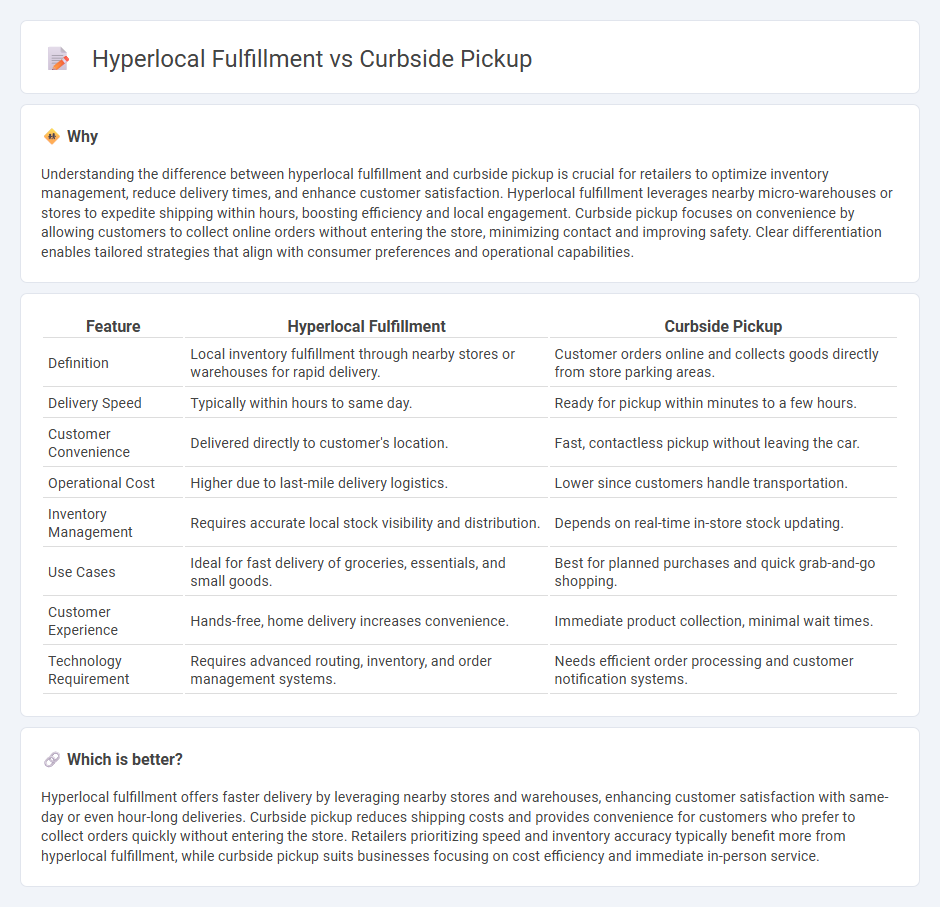
Hyperlocal fulfillment leverages local inventory to expedite order delivery within a specific geographic area, enhancing customer convenience through faster shipping times. Curbside pickup offers shoppers the ability to collect online orders directly from store parking lots, minimizing wait times and in-store contact. Explore the advantages and operational differences of hyperlocal fulfillment and curbside pickup to optimize your retail strategy.
Why it is important
Understanding the difference between hyperlocal fulfillment and curbside pickup is crucial for retailers to optimize inventory management, reduce delivery times, and enhance customer satisfaction. Hyperlocal fulfillment leverages nearby micro-warehouses or stores to expedite shipping within hours, boosting efficiency and local engagement. Curbside pickup focuses on convenience by allowing customers to collect online orders without entering the store, minimizing contact and improving safety. Clear differentiation enables tailored strategies that align with consumer preferences and operational capabilities.
Comparison Table
| Feature | Hyperlocal Fulfillment | Curbside Pickup |
|---|---|---|
| Definition | Local inventory fulfillment through nearby stores or warehouses for rapid delivery. | Customer orders online and collects goods directly from store parking areas. |
| Delivery Speed | Typically within hours to same day. | Ready for pickup within minutes to a few hours. |
| Customer Convenience | Delivered directly to customer's location. | Fast, contactless pickup without leaving the car. |
| Operational Cost | Higher due to last-mile delivery logistics. | Lower since customers handle transportation. |
| Inventory Management | Requires accurate local stock visibility and distribution. | Depends on real-time in-store stock updating. |
| Use Cases | Ideal for fast delivery of groceries, essentials, and small goods. | Best for planned purchases and quick grab-and-go shopping. |
| Customer Experience | Hands-free, home delivery increases convenience. | Immediate product collection, minimal wait times. |
| Technology Requirement | Requires advanced routing, inventory, and order management systems. | Needs efficient order processing and customer notification systems. |
Which is better?
Hyperlocal fulfillment offers faster delivery by leveraging nearby stores and warehouses, enhancing customer satisfaction with same-day or even hour-long deliveries. Curbside pickup reduces shipping costs and provides convenience for customers who prefer to collect orders quickly without entering the store. Retailers prioritizing speed and inventory accuracy typically benefit more from hyperlocal fulfillment, while curbside pickup suits businesses focusing on cost efficiency and immediate in-person service.
Connection
Hyperlocal fulfillment leverages nearby inventory hubs to enable rapid order processing and delivery, enhancing the efficiency of curbside pickup services by offering customers immediate access to products. Retailers using hyperlocal strategies decrease delivery times and reduce logistical costs, improving customer satisfaction through faster, contactless transactions at designated pickup points. This integration supports seamless omnichannel experiences, boosting sales conversion and operational agility in competitive retail markets.
Key Terms
Order Aggregation
Order aggregation plays a crucial role in both curbside pickup and hyperlocal fulfillment by consolidating multiple customer orders to optimize delivery routes and reduce costs. In curbside pickup, orders are grouped based on store location and pickup times, enhancing efficiency for in-store staff and customers. Explore how advanced order aggregation strategies can transform your fulfillment operations.
Last-Mile Delivery
Curbside pickup offers consumers a convenient option by allowing orders to be collected directly from store premises, minimizing delivery time and reducing logistical complexities in last-mile delivery. Hyperlocal fulfillment leverages nearby micro-warehouses and local stores to expedite product availability and ensure rapid delivery within tight geographic areas, enhancing customer satisfaction through speed and efficiency. Explore more about last-mile delivery innovations and how they transform consumer experiences in evolving retail landscapes.
Inventory Proximity
Inventory proximity plays a crucial role in curbside pickup by enabling retailers to store products closer to customers, reducing wait times and enhancing convenience. Hyperlocal fulfillment leverages localized inventory distributed across multiple micro-warehouses, ensuring rapid delivery and better stock availability in dense urban areas. Explore the advantages of each strategy to optimize your supply chain and satisfy consumer demand effectively.
Source and External Links
The Ultimate Guide to Curbside Pickup (+ Examples) - Curbside pickup lets customers order online, pay, and then drive to the store to have their order brought directly to their car, offering a convenient alternative that saves shipping costs and wait time.
How Does Curbside Pickup Work? Everything you need to ... - Curbside pickup, also known as BOPIS or click and collect, involves ordering online and retrieving the order by parking outside the store where staff place the items directly in the customer's vehicle, enabling a seamless and time-saving process.
Curbside Pickup - Customers select curbside pickup at checkout, receive notification when the order is ready, check in via app, park in a designated spot, and store staff load the order into their vehicle, making the service contactless and quick.
 dowidth.com
dowidth.com